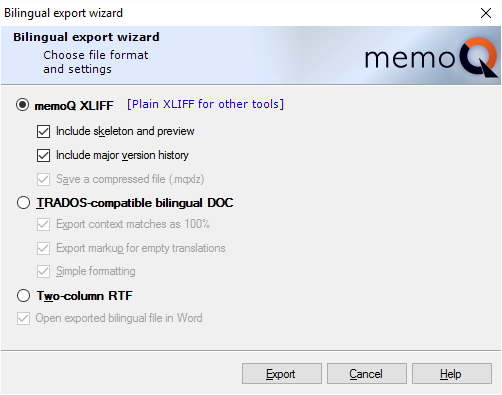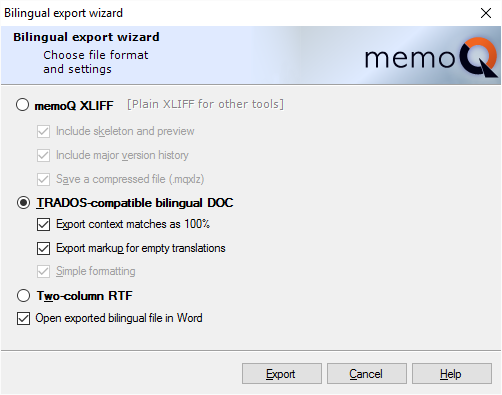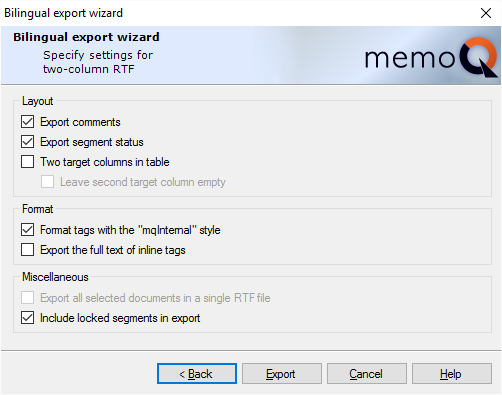|
Using this dialog, you can export one or more translation documents in a bilingual document. memoQ supports three types of bilingual documents: the memoQ XLIFF format, the TRADOS-compatible bilingual Word files, and a two-column RTF format.
How to beginIn the Translations pane of Project home – either on the Documents or the Views tab –, select one or more documents or views, and, on the Documents ribbon, click Export, and then click Export Bilingual. Alternatively, you can right-click the selected documents or views, and choose Export, and then Export bilingual from the popup menu. UseSelect the memoQ XLIFF, TRADOS-compatible bilingual DOC or the Two-column RTF option for the desired bilingual document format. Then, use the check boxes (where applicable) to fine-tune the export. When you selected the document format, and adjusted the options, click Export. Then you will be able to select the location and name of the file(s) to export the document(s) into. For different settings, refer to the following sections: •Trados-compatible bilingual DOC settings •Behavior with multiple target languages Use the regular Import command to update existing projects from bilingual documents: You need to export a bilingual document when it must be processed somewhere else, outside memoQ. In this case, you usually receive a slightly modified version of the same bilingual document, and you will need to update your existing memoQ project from it. In this case, simply open the memoQ project, and import the document. memoQ will detect that this is a bilingual document, but not only that: it will also find the original document that needs to be updated.
memoQ XLIFF settingsXLIFF is a standard bilingual document format based on the XML language. In memoQ, XLIFF is treated as a native bilingual document format. XLIFF files can be edited in third-party tools outside memoQ. When exporting a document to memoQ XLIFF, you can set the following options: •Include skeleton and preview check box: When checked, memoQ exports the formatting information into the memoQ XLIFF file along with the translation units. If another user imports the resulting XLIFF file in her copy of memoQ, she will be able to export the formatted translation. If you do not include the skeleton, this is not possible. Use this option when the XLIFF file will be processed in another copy of memoQ. Uncheck this check box if you plan to transfer the document to a different tool because the formatting skeleton is memoQ-specific, and no other tool can restore the formatted translation from it. •Include major version history: This includes the version history of the documents in the export. •Save a compressed file check box: For smaller file size, check this check box. memoQ creates XLIFF files in a ZIP (*.mqxlz). MQXLZ cannot be imported into other tools. You need to export as *.mqxliff. In order to do this, click the [Plain XLIFF for other tools] link. This will automatically deactivate all check boxes that are needed for a MQXLZ export and will generate MQXLIFF files. TRADOS-compatible bilingual DOC settingsTrados-compatible bilingual DOC files are legacy bilingual Word documents using special styles, hidden text and text protection. These files are created by SDL Trados versions 2007 or earlier. This document type was abandoned in SDL Trados Studio 2009, but in many organizations, this type of DOC file is still a standard way of transferring bilingual documents. memoQ can save fully formatted bilingual Word documents if the source document was a pre-segmented Trados-compatible bilingual Word document. From documents of other formats, memoQ can save an unformatted bilingual Word document, which is useful if the document needs to be reviewed in Word, and then returned to memoQ. Important: To export your work in a fully formatted bilingual Word document, the original document must be a pre-segmented Trados-compatible bilingual Word document. With Trados-compatible bilingual documents, you can set the following options: •Export context matches as 100% check box: SDL Trados 2007 and earlier versions do not support context matches similar to the 101% matches is memoQ. If the exported bilingual document will be transferred to Trados, check this check box. When indicating the match rate in the document, memoQ will use 100% wherever 101% occurs. •Export markup for empty translations check box: If checked, memoQ will export necessary hidden tags for segments that were not translated. If you uncheck this check box, memoQ will export untranslated source segments without any Trados-style Word markups. •Simple formatting check box: When checked, memoQ exports the document contents without the original formatting. This is the only option if the source document is a DOC or RTF file and is converted to DOCX on import into your local memoQ project.
How to: 1.Import your DOC or RTF file using the DOCX option. The files will be converted to DOCX on import. 2.Export the imported file as Trados-compatible bilingual DOC file. This might be the case to send the file to your colleague who still uses Trados 2007. On the Documents ribbon tab, choose Export > Export Bilingual. Choose the TRADOS-compatible bilingual DOC radio button. This way, you ensure that you are able to update your document when you receive back the translated or reviewed Trados bilingual DOC file from your colleague. 3.To import the translated Trados bilingual DOC file, go to the Documents ribbon tab, choose Import > Import With Options. memoQ recognized the file and automatically chooses the Update action to update the file in your project. Note: This is intended for memoQ desktop application using a multilingual export in local projects. Behavior in projects with multiple target languagesWhen you work in a multilingual project, and the language selector in the Translations pane of Project home is set to All languages, the Bilingual export wizard and behaves a little different. The dialog for choosing the format and adjusting the options becomes the first page of a two-page wizard. After you make your selections, you need to click Next instead of Export. Then a second wizard page appears: The document will be exported into a separate file for each target language. In this wizard page, you can choose whether you want to export all files into a single folder, and have the language code in the file names (Append language code to file name radio button), or export all files into separate folders, where the folders are named after the language code (Create subfolders for each language radio button). It is best to choose the first radio button if you are exporting a single document, and the second one if you are exporting multiple documents. After you make your selection, click Export. Then you will be able to select the location and name of the file to export the document into. Important: memoQ does not display the second wizard page if you select one of the target languages in the language selector of Project home. Important: To set up multilingual projects, you need the memoQ project manager edition. Multilingual projects are not available in the translator pro edition. Two-column RTF settingsIf you choose the two-column RTF format, the second page of the wizard looks like this: Through this wizard page, you can control how memoQ creates the two-column RTF document. Layout section: •Export comments check box: If you tick this, memoQ creates an extra column in the table with the comments exported from the selected document. This option is turned on by default. •Export segment status check box: If you tick this, memoQ creates an extra column in the table that shows the segment status: both the colors and the match rate. This option is turned on by default. •Two target columns in table check box: If you tick this, memoQ exports the target column twice. In the word processor, the reviewer should leave the first target column intact, and modify the second target column. If this option is turned on, the Leave second target column empty check box is also active, where you can instruct memoQ to omit the text from the second target column. Both options are turned off by default. Format section: •Format tags with the "mqInternal" style check box: If this is ticked, all characters belonging to formatting tags will be formatted with the "mqInternal" style. Documents exported in this fashion are easier for memoQ to import or update, and it is also easier to spot any formatting errors in the bilingual RTF table. This option is turned on by default. •Export the full text of inline tags check box: If this is ticked, memoQ exports all text in all inline tags. This might make the document extremely difficult to read. On the other hand, the contents of inline tags reveal a lot of information about the formatting of the document. This option is turned off by default. Miscellaneous section: •Export all selected documents in a single RTF file check box: memoQ can include multiple documents in a single multi-column RTF document. This check box is available if you select more than one document. If you tick this check box, memoQ will create a single RTF document, holding the contents of all selected documents. The table has multiple headers to provide for identifying each document. This option is turned off by default. •Include locked segments in export check box: memoQ can omit locked segments from the exported RTF document. This prevents the reviewer from accidentally changing text that should be left unchanged. On the other hand, reviewing the text can become difficult if some parts are missing. This option is turned off by default. To export as two-column RTF is helpful if your colleague does not have a CAT tool and would like to proofread in Word. Send the two-column RTF file to your colleague who will make changes and might leave comments. When you receive the file back, go to your memoQ project, select the file in your project. Then, on the Documents ribbon tab, choose Import > Update from bilingual. memoQ will recognize the file and will update your existing file with the changes from your colleague. You can then use Track changes to see the changes your colleague made. Use the translation grid filtering to look for rows that have comments. NavigationClick Cancel to leave the wizard without exporting any documents. In the second wizard page, click Back to return to the first page and select the bilingual document format again. If you click Export, memoQ exports the selected document(s) in the chosen bilingual format, then closes the wizard.
See also: Knowledge Base article: Bilingual export formats and handling outside of memoQ |



